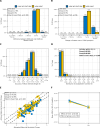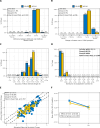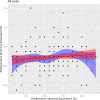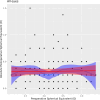Stability of refractive outcomes after hyperopic LASIK with and without Mitomycin C application: a randomized controlled trial
- PMID: 39762309
- PMCID: PMC11704336
- DOI: 10.1038/s41598-024-83757-x
Stability of refractive outcomes after hyperopic LASIK with and without Mitomycin C application: a randomized controlled trial
Abstract
To assess the efficacy, safety, and stability of refractive outcomes in hyperopic Laser-Assisted in Situ Keratomileusis (LASIK) with and without the application of Mitomycin C (MMC). This randomized, parallel group, controlled multicenter trial included 140 hyperopic eyes. The participants were randomly assigned to two groups: one receiving LASIK with mitomycin C (MMC) (n = 70) and the other receiving LASIK without MMC (n = 70). The primary outcome measures were uncorrected distance visual acuity (UDVA), corrected distance visual acuity (CDVA), and safety parameters at six months postoperatively. The statistical analysis employed t-tests, Mann-Whitney tests, and Fisher's Exact Test, with a significance level of p < 0.05. All 140 eyes (70 per group) were analyzed. No statistically significant differences were identified between the two groups in postoperative UDVA, CDVA, or safety parameters (p > 0.05). Both groups demonstrated highly effective and safe refractive outcomes. No intraoperative complications or postoperative adverse events were observed. Age and preoperative spherical equivalent did not significantly affect outcomes. Hyperopic LASIK with and without MMC showed comparable efficacy, safety, and stability of refractive outcomes at the six-month postoperative interval. Although MMC use in hyperopic LASIK appears to be a safe procedure, it was not found to be significantly superior to conventional LASIK. Further investigation with longer follow-up periods and larger cohorts is necessary to confirm these results.
Keywords: Laser-in-Situ-Keratomileusis; MMC; Mitomycin C; Refractive outcome; Refractive surgery.
© 2024. The Author(s).
Conflict of interest statement
Declarations. Competing interests: The authors declare no competing interests.
Figures




Similar articles
-
Femtosecond Laser-Assisted LASIK With and Without the Adjuvant Use of Mitomycin C to Correct Hyperopia.J Refract Surg. 2018 Jan 1;34(1):23-28. doi: 10.3928/1081597X-20171116-01. J Refract Surg. 2018. PMID: 29315438
-
LASIK-induced corneal changes after correction of hyperopia with and without application of Mitomycin-C.BMC Ophthalmol. 2019 Apr 23;19(1):93. doi: 10.1186/s12886-019-1100-7. BMC Ophthalmol. 2019. PMID: 31014283 Free PMC article. Clinical Trial.
-
Wavefront excimer laser refractive surgery for adults with refractive errors.Cochrane Database Syst Rev. 2020 Dec 18;12(12):CD012687. doi: 10.1002/14651858.CD012687.pub2. Cochrane Database Syst Rev. 2020. PMID: 33336797 Free PMC article.
-
Long-term assessment of visual and refractive outcomes of laser in situ keratomileusis for hyperopia using the AMARIS® 750S Excimer laser.J Fr Ophtalmol. 2019 Sep;42(7):703-710. doi: 10.1016/j.jfo.2019.02.006. Epub 2019 May 24. J Fr Ophtalmol. 2019. PMID: 31130390
-
Effect of mitomycin-C on the variance in refractive outcomes after photorefractive keratectomy.J Cataract Refract Surg. 2014 Dec;40(12):1980-4. doi: 10.1016/j.jcrs.2014.02.048. Epub 2014 Oct 8. J Cataract Refract Surg. 2014. PMID: 25305150
References
-
- Wen, D. et al. Postoperative efficacy, predictability, Safety, and visual quality of laser corneal refractive surgery: a Network Meta-analysis. Am. J. Ophthalmol.178, 65–78. 10.1016/j.ajo.2017.03.013 (2017). - PubMed
-
- Alió, D. et al. Femtosecond Laser-assisted in situ Keratomileusis for the treatment of moderate to high hyperopia. J. Cataract Refract. Surg.10.1097/j.jcrs.0000000000001153 (2023). - PubMed
-
- Kaluzny, B. J. et al. Three-year outcomes after high hyperopia correction using photorefractive keratectomy with a large ablation zone. Br. J. Ophthalmol.103, 849–854. 10.1136/bjophthalmol-2017-311694 (2019). - PubMed
-
- Gauthier-Fournet, L., Penin, F. & Arba Mosquera, S. Six-Month outcomes after high hyperopia correction using laser-assisted in situ keratomileusis with a large ablation zone. Cornea38, 1147–1153. 10.1097/ico.0000000000002011 (2019). - PubMed
Publication types
MeSH terms
Substances
LinkOut - more resources
Full Text Sources

